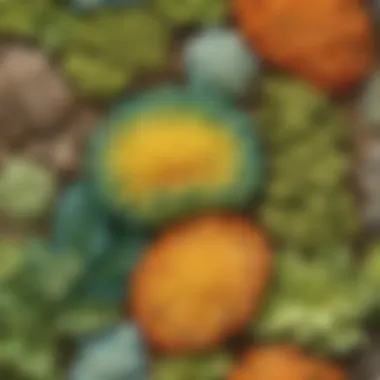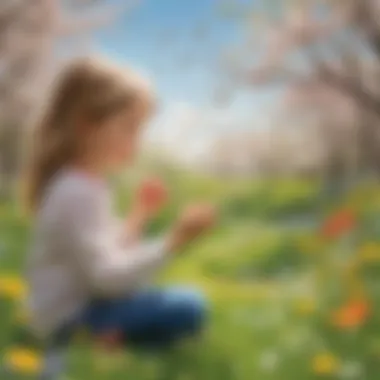Unlocking the Wonders of Spring with Engaging Science Activities for Young Minds


Science Fun Facts
Come explore a variety of intriguing fun facts related to science that will leave you astounded. From fascinating trivia to quirky science stories and mind-boggling records, get ready to dive into the captivating world of scientific wonders!
Discover the Wonders of Science
Embark on an exciting journey delving into various scientific phenomena and concepts that will broaden your understanding of the world around you. Engage with educational videos, animations, and interactive learning tools that bring science to life. Discover the practical applications of science in everyday scenarios through real-life examples that showcase the relevance of scientific knowledge.
Science Quiz Time
Challenge yourself with interactive quizzes and thought-provoking questions designed to test your scientific knowledge. Explore multiple choice questions that will encourage critical thinking and brain teasers that will stimulate your problem-solving skills. Engage in learning through gamification, making the process of acquiring knowledge both educational and enjoyable.
Science Experiment Showcase
Immerse yourself in a world of fun and engaging science experiments that will spark your curiosity and passion for discovery. Follow step-by-step instructions to conduct experiments using simple materials that can be found at home. Prioritize safety with essential tips and precautions to ensure a safe and enjoyable scientific exploration.
Introduction to Spring Sensory Activities
Spring is a season of rejuvenation and growth, making it an ideal time to engage young minds in hands-on sensory experiences. In this article, we dive into the world of Spring Sensory Activities, tailored for children aged 6-12. These activities not only offer a fun way to explore the wonders of the season but also serve as powerful educational tools, blending entertainment with learning seamlessly.
Understanding Sensory Play
Benefits of sensory play
Sensory play holds a significant role in child development by stimulating various senses such as touch, sight, and sound. It enhances cognitive abilities, promotes problem-solving skills, and encourages creativity. The key characteristic of sensory play lies in its ability to engage children of all developmental levels, making it an inclusive choice for fostering holistic growth and discovery among young learners. Despite its advantages, occasional supervision is necessary to ensure a safe and enriching sensory play environment.
Importance of sensory experiences in child development


Sensory experiences play a crucial role in enhancing children's cognitive, social, and emotional development. By engaging with different sensory stimuli, children can sharpen their perception, improve their motor skills, and build a strong foundation for learning. Understanding the importance of sensory experiences in child development underscores the need for varied sensory activities that cater to all aspects of a child's growth. While the benefits are plentiful, it's essential to introduce sensory experiences in a structured and safe manner to maximize their positive impact.
Introducing Spring-themed Activities
Exploring the connection between spring and senses
Spring serves as a source of inspiration for sensory activities due to its vibrant colors, fresh scents, and diverse textures. Exploring the relationship between spring and the senses not only enriches children's knowledge of the season but also allows them to appreciate nature's beauty in a hands-on manner. The unique feature of spring-themed sensory activities is their ability to captivate young learners, fostering a deeper connection with the environment while honing their sensory perception skills. However, balancing sensory input and ensuring age-appropriate activities are essential considerations when introducing spring-themed experiences to children.
Engaging Nature-inspired Sensory Activities
In the realm of sensory experiences for young science enthusiasts, exploring nature-inspired activities holds immense significance. It provides children with a tangible connection to the natural world, fostering curiosity and a deeper understanding of the environment around them. Engaging in nature-inspired sensory activities not only stimulates the senses but also encourages a sense of appreciation for the beauty and intricacies of the natural world. By immersing themselves in these activities, children can develop a stronger bond with nature while honing their observational skills and scientific inquiry.
Sensory Garden Exploration
Creating a sensory garden
The concept of creating a sensory garden introduces children to the joys of cultivating plant life while engaging their senses on multiple levels. By planting a variety of flowers, herbs, and tactile plants, children can experience different textures, scents, and colors firsthand. This sensory-rich environment not only enhances their sensory perception but also provides a platform for learning about plant biology and ecosystem dynamics. The tactile engagement with the soil, leaves, and petals in a sensory garden offers a hands-on approach to understanding the interconnectedness of living organisms in nature.
Identifying different plants and textures
Exploring the multitude of plants and textures within a sensory garden paves the way for children to learn how to differentiate between various species based on visual and tactile cues. Identifying plants not only sharpens observational skills but also instills a sense of responsibility as children care for and nurture these living entities. By recognizing the unique textures of leaves, the varied fragrances of flowers, and the diversity of colors in a garden, children expand their botanical knowledge and develop a keen eye for detail, which is crucial in scientific exploration.
Nature Scavenger Hunt
Collecting natural treasures
Engaging in a nature scavenger hunt offers children the opportunity to hunt for natural treasures such as fallen leaves, interesting rocks, or unique flora. This activity promotes outdoor exploration, physical movement, and the thrill of discovery. Collecting natural items triggers the curiosity of children, prompting them to observe and select items based on their texture, shape, or color. It encourages them to appreciate the beauty of natural artifacts, fostering a connection with the environment.


Utilizing senses to explore the environment
By using their senses to navigate and explore the environment during a scavenger hunt, children develop a deeper appreciation for the biodiversity around them. Listening for rustling leaves, feeling the rough bark of a tree, or inhaling the scent of wildflowers enhances their sensory awareness and connection to nature. Utilizing senses such as touch, smell, and sight during the scavenger hunt not only heightens their exploration experience but also encourages them to engage with the environment in a meaningful and memorable way.
Birdwatching and Listening
Observing bird behaviors
Birdwatching provides children with a window into the avian world, allowing them to observe and interpret bird behaviors in their natural habitat. By watching birds feed, interact, and communicate, children gain valuable insights into animal behavior and ecosystem dynamics. Observing bird behaviors fosters a sense of environmental awareness and empathy towards wildlife, encouraging children to become keen observers of the natural world.
Listening to different bird songs
Listening to the melodic tunes of various bird species not only enhances auditory perception but also introduces children to the concept of biodiversity through sound. Differentiating between the chirps, calls, and songs of different bird species trains children's auditory acumen and hones their ability to identify avian species by sound. By immersing themselves in the symphony of bird songs, children develop a deeper appreciation for the intrinsic beauty and diversity of nature's acoustic landscape.
Interactive Sensory Play Ideas
Interactive Sensory Play Ideas play a crucial role in this enriched article exploring Spring Sensory Activities for children showing a keen interest in science. By integrating interactive play elements, children engage in hands-on learning experiences that stimulate curiosity and promote scientific exploration. The specific focus on Interactive Sensory Play Ideas aims to provide a dynamic platform for young learners to discover and immerse themselves in carefully curated activities tailored to their cognitive and sensory development. One of the central aspects highlighted in this section is the seamless blend of fun and educational components within these activities, ensuring that children not only enjoy themselves but also gain valuable insights into the scientific concepts explored.
DIY Sensory Bins
Creating thematic sensory bins
Creating thematic sensory bins offers a hands-on approach to sensory play by organizing materials and objects according to specific themes. This method enriches the overall sensory experience by immersing children in a cohesive and stimulating environment designed to captivate their senses. The key characteristic of these thematic bins lies in their ability to enhance children's cognition and sensory perception through the exploration of distinct themes such as textures, colors, or varying sensory stimuli. This deliberate organization of materials provides a structured yet engaging avenue for children to delve into sensory learning, fostering creativity and critical thinking skills.
Incorporating various textures and materials
Incorporating a diverse range of textures and materials into sensory bins enriches the tactile experience and broadens sensory exploration for young learners. By introducing items with varied tactile qualities, such as smooth, rough, soft, or bumpy textures, children are encouraged to engage their sense of touch and develop a nuanced understanding of different material properties. This deliberate inclusion of sensory diversity not only enhances the overall sensory play experience but also promotes sensory integration and cognitive development in children, making it a beneficial choice for this article. Despite the advantages of offering a multisensory experience, careful consideration must be given to the selection and safety of materials to ensure a positive and secure sensory environment.


Sensory Art Projects
Exploring colors and textures through art
Exploring colors and textures through art presents a creative avenue for children to express themselves while engaging in sensory exploration. By encouraging young artists to experiment with different hues, tones, and textures, this aspect of sensory art projects sparks imaginative thinking and hones aesthetic sensibilities. The key characteristic of this activity lies in its ability to evoke emotional responses and provoke sensory stimulation through visual and tactile elements, making it a popular choice for integrating art into sensory experiences. Children not only gain exposure to diverse artistic mediums but also develop an appreciation for the sensory aspects of creative expression, enhancing their aesthetic awareness and cognitive skills. However, it is essential to provide age-appropriate materials and guidance to ensure a safe and engaging artistic experience for young participants.
Creating sensory-friendly art pieces
Creating sensory-friendly art pieces involves designing art projects that are accessible and enjoyable for children of all sensory sensitivities. This approach aims to cater to diverse sensory needs by adapting art materials and techniques to accommodate individual preferences and challenges. The unique feature of sensory-friendly art pieces lies in their inclusive design, which fosters a supportive and engaging artistic environment for all participants. By prioritizing sensory considerations in art creation, children with varying sensory profiles can actively participate and benefit from the enriching experiences offered by sensory art projects. Despite the advantages of promoting inclusivity and creative expression, careful attention must be given to creating a sensory-safe space and providing appropriate support for children with specific sensory requirements.
Sensory Science Experiments
Engaging in hands-on scientific explorations
Engaging in hands-on scientific explorations allows children to immerse themselves in interactive experiments that stimulate curiosity and promote scientific inquiry. By actively participating in scientific activities, young learners develop practical skills, critical thinking abilities, and a deeper understanding of scientific concepts. The key characteristic of this experiential learning approach lies in its ability to foster investigative curiosity and hands-on problem-solving skills, making it a popular choice for integrating science into sensory experiences. Through engaging experiments, children not only explore scientific principles but also enhance their observational skills and analytical thinking, cultivating a passion for scientific exploration. However, it is essential to ensure the safety and appropriate supervision of children during scientific experiments to create a secure and enriching learning environment.
Stimulating the senses through experiments
Stimulating the senses through experiments involves designing scientific activities that activate and engage multiple sensory modalities in children. This approach aims to enrich the learning experience by incorporating sensory stimuli, such as sights, sounds, textures, and scents, to evoke tactile, auditory, and olfactory responses. The unique feature of sensory-based experiments lies in their ability to provide a multidimensional learning experience that reinforces scientific concepts while stimulating sensory awareness. By integrating sensory elements into experiments, children develop a holistic understanding of scientific phenomena and sharpen their sensory perception, contributing to a comprehensive and engaging educational experience. Despite the advantages of sensory-rich experiments in enhancing learning outcomes, careful planning and consideration of safety measures are essential to ensure a meaningful and safe scientific exploration environment for young participants.
conclusion
In the culmination of this comprehensive guide on Spring Sensory Activities for Young Science Enthusiasts, it is crucial to reflect on the critical importance of sensory experiences in a child's developmental journey. Sensory activities serve as a gateway to understanding the world around us, allowing youngsters to engage their senses and spark curiosity. By immersing themselves in these activities, children not only enhance their cognitive skills but also develop a profound appreciation for nature and science. Furthermore, embracing sensory experiences fosters creativity, improves sensory processing abilities, and cultivates empathy towards the environment. It is through sensory play that children can hone their motor skills, language development, and social interactions. These activities lay the foundation for a lifelong love of learning and exploration, shaping young minds into inquisitive and confident individuals ready to navigate the complexities of the world. A key takeaway from this conclusion is the recognition of sensory experiences as indispensable tools for holistic child development. By encouraging young ones to embrace these activities, we nurture their sense of wonder and enrich their educational journey by blending scientific concepts with the joys of discovery and hands-on exploration.
Embracing Spring with Sensory Adventures
Reflecting on the Importance of Sensory Experiences
Diving deeper into the realm of sensory experiences, it becomes evident that reflection plays a pivotal role in solidifying the impact these activities have on children. Reflecting on sensory experiences allows young learners to process their emotions, thoughts, and observations, leading to a deeper understanding of the learning process. By encouraging reflection, parents and educators can enhance a child's cognitive abilities, emotional intelligence, and self-awareness. This introspective practice instills a sense of mindfulness and appreciation for the learning journey, promoting resilience and creativity in problem-solving skills. Through reflection, children can connect with their experiences on a deeper level, making meaningful associations between sensory stimuli and their understanding of the world.
Inspiring Continued Exploration and Curiosity
Inspiration is the driving force behind continued exploration and curiosity in young science enthusiasts. By igniting a sense of wonder and awe, children are motivated to seek out new challenges, investigate unknown phenomena, and engage in self-directed learning. This curiosity-driven exploration cultivates a growth mindset, encouraging children to persevere in the face of challenges and embrace learning as a lifelong adventure. Fostering a spirit of curiosity not only cultivates a passion for science but also nurtures essential skills such as critical thinking, problem-solving, and adaptability. Through hands-on sensory activities and open-ended exploration, children develop a sense of agency and confidence in their abilities, creating a solid foundation for future academic and personal success. By inspiring continued exploration and curiosity, we empower young minds to question, discover, and innovate, shaping them into lifelong learners with a thirst for knowledge and discovery.







